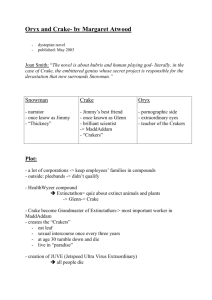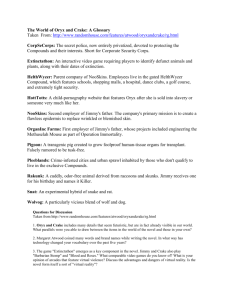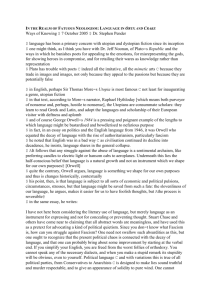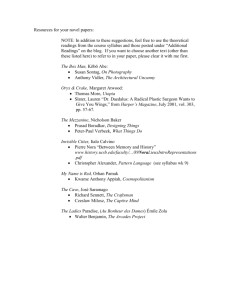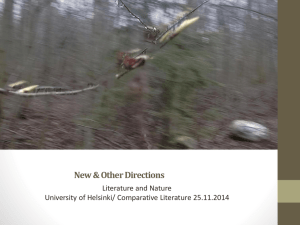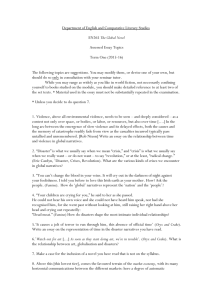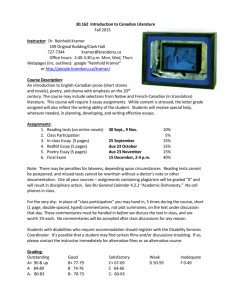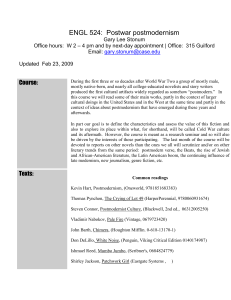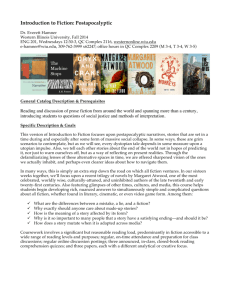Exploring Technology and Surveillance in Margaret Atwood's
advertisement
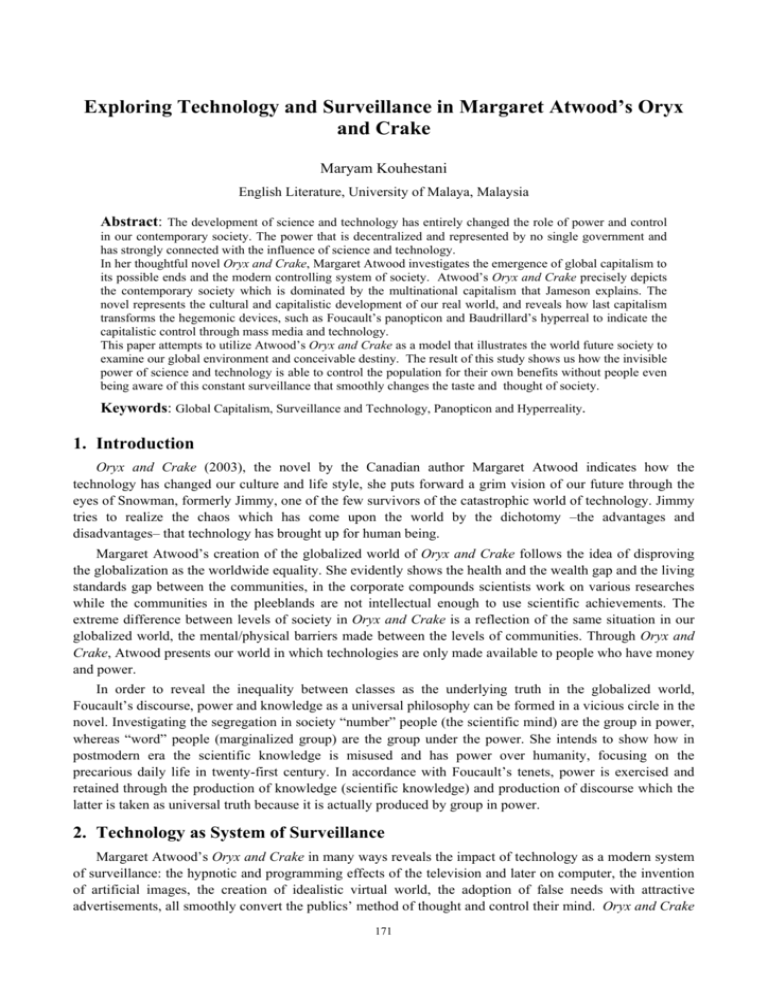
Exploring Technology and Surveillance in Margaret Atwood’s Oryx and Crake Maryam Kouhestani English Literature, University of Malaya, Malaysia Abstract: The development of science and technology has entirely changed the role of power and control in our contemporary society. The power that is decentralized and represented by no single government and has strongly connected with the influence of science and technology. In her thoughtful novel Oryx and Crake, Margaret Atwood investigates the emergence of global capitalism to its possible ends and the modern controlling system of society. Atwood’s Oryx and Crake precisely depicts the contemporary society which is dominated by the multinational capitalism that Jameson explains. The novel represents the cultural and capitalistic development of our real world, and reveals how last capitalism transforms the hegemonic devices, such as Foucault’s panopticon and Baudrillard’s hyperreal to indicate the capitalistic control through mass media and technology. This paper attempts to utilize Atwood’s Oryx and Crake as a model that illustrates the world future society to examine our global environment and conceivable destiny. The result of this study shows us how the invisible power of science and technology is able to control the population for their own benefits without people even being aware of this constant surveillance that smoothly changes the taste and thought of society. Keywords: Global Capitalism, Surveillance and Technology, Panopticon and Hyperreality. 1. Introduction Oryx and Crake (2003), the novel by the Canadian author Margaret Atwood indicates how the technology has changed our culture and life style, she puts forward a grim vision of our future through the eyes of Snowman, formerly Jimmy, one of the few survivors of the catastrophic world of technology. Jimmy tries to realize the chaos which has come upon the world by the dichotomy –the advantages and disadvantages– that technology has brought up for human being. Margaret Atwood’s creation of the globalized world of Oryx and Crake follows the idea of disproving the globalization as the worldwide equality. She evidently shows the health and the wealth gap and the living standards gap between the communities, in the corporate compounds scientists work on various researches while the communities in the pleeblands are not intellectual enough to use scientific achievements. The extreme difference between levels of society in Oryx and Crake is a reflection of the same situation in our globalized world, the mental/physical barriers made between the levels of communities. Through Oryx and Crake, Atwood presents our world in which technologies are only made available to people who have money and power. In order to reveal the inequality between classes as the underlying truth in the globalized world, Foucault’s discourse, power and knowledge as a universal philosophy can be formed in a vicious circle in the novel. Investigating the segregation in society “number” people (the scientific mind) are the group in power, whereas “word” people (marginalized group) are the group under the power. She intends to show how in postmodern era the scientific knowledge is misused and has power over humanity, focusing on the precarious daily life in twenty-first century. In accordance with Foucault’s tenets, power is exercised and retained through the production of knowledge (scientific knowledge) and production of discourse which the latter is taken as universal truth because it is actually produced by group in power. 2. Technology as System of Surveillance Margaret Atwood’s Oryx and Crake in many ways reveals the impact of technology as a modern system of surveillance: the hypnotic and programming effects of the television and later on computer, the invention of artificial images, the creation of idealistic virtual world, the adoption of false needs with attractive advertisements, all smoothly convert the publics’ method of thought and control their mind. Oryx and Crake 171 reveals the power in the capitalist society, the power that is decentralized and represented by no single government. Ultimately, the shift focuses on who utilizes power in capitalist system, which power has strongly connected with technology advances, particularly in the productions and the dissemination of information. The order of this new world is something quite similar to Foucault’s depiction of panopticon society. Foucault’s term has been appropriated by a variety of disciplines to refer to a system where the powerful minority dominates the enervation majority through coercion rather than direct force. Foucault examines how surveillance has become an instrument for governments or other organizations to maintain power. He uses panopticon as a model for total surveillance, and as a metaphor for how contemporary power operates. He argues that in civilized societies, methods of surveillance have moved from the exterior to the interior, a notable shift from the force of the monarchical states to the internalized coercion of modern “democracies”. The modern state efforts to rely on internalized rules and make a ubiquitous –all seeing – appearance on society. This system of appearance and control is created through a number of new equipments: Propagation of media images depicting the expansion of surveillance in everyday life. The increasing of technology, power and control are no longer upheld by punishment and physical control but instead by overshadowing necessity of submission and surveillance. Foucault (1995) argues, like the prison in the panopticon dungeon, the citizen is seen but he does not see, “he is the object of information never the subject of communication.” (p.200) In Oryx and Crake individuals are observed either directly or indirectly, but are totally incapable of seeing the “reality” of their situation. They are absolutely fascinated by the magical power of the latest technology: propagandas, television, internet and other instruments of technology each in their own way, operate as a system of surveillance to control and shape the publics’ mind and desire. When discussing panopticon’s design, Foucault states, “Bentham laid down the principle that power should be visible and unverifiable” (p.201), one can understand this statement in dystopian fiction like Oryx and Crake, in postmodern reality the authority relies on the exercise of power with little responsibility. The power Foucault depicts can be seen in numerous ways throughout postmodern society, but its most evident may be with the way the development of television and computer interacts in society. Countless hours are spent passively with these two technologies; both create a disappointed experience as they remove the human from the real world and make a fabulous utopia through this virtual world. Even when in computer activities individuals have interconnection with others, the lack of human presence still puts its effect on the individual and not the communal one. Regarding this point in western society the interaction of human even in real society is getting dissuadable, individual feels depressive and isolated even among the members of society, as Foucault cites, “The crowd, a compact mass, a locus of multiple exchanges, individualities merging together, a collective effect, is abolished and replaced by collection of separated individualities” (p.203). 3. The Impact of Capitalism and Technology on Society Atwood’s novel is a reaction to the world she experiences and a reflection to the controlling system of contemporary society. The capitalist corporations which in many ways put companies in competition with governments, and even make them to act more powerful in society than the governments. Oryx and Crake can be elaborated by the theories of postmodernism and late capitalism argued by Fredrick Jameson. Jameson’s work centers on defining the postmodern condition as a reaction to the present stage of capitalistic development. Jameson sees recent human history as a series of reactions to capitalism. According to Jameson, capitalism has undergone three stages: early competitive capitalism, monopoly capitalism that reigned during the modern period, and multinational or “late” capitalism, which coincides with the postmodern period. He suggests that postmodernity coincides with the final, “late” form of capitalism, and the merger of various public and private sectors resonates throughout every citizen’s daily life and interactions with “reality.” Jameson (1991) remarks: “what “late” generally conveys is…the sense that something has changed, that things are different, that we have gone through a transformation of the life world which is something decisive but incomparable with the older convulsions of modernization and industrialization, less perceptible and dramatic, somehow, but more permanent precisely because more thoroughgoing and all-pervasive.” (p.xxi) Jameson’s analysis of the postmodern era provides unique insight into the world of Atwood’s Oryx 172 and Crake and also helps us understand how many of the novel’s themes extrapolate on our own reality. His theories also help to provide an explanation for how the novel represents the shift in hegemonic systems that coincides with changing economic conditions from modernism to postmodernism. Jameson’s argument, in many ways associated with those of Baudrillard and Foucault, provides an understanding of how postmodern conditions are fully comprehensible in Atwood’s novel. A clear connection can be found between Jameson’s theories and Atwood’s novel, as she illustrates the contemporary society which is dominated by the multinational capitalism Jameson explains. In Oryx and Crake we can realize how precisely Atwood represents contemporary culture and capitalistic development of our real world, and how last capitalism transforms the hegemonic devices, such as Foucault’s panopticon and Baudrillard’s hyperreal to indicate the multinational capitalistic control through mass media and technology. For instance, the system of surveillance used in Oryx and Crake depicts a world where the populace like Jimmy and Crake are free to observe all the illicit material on the internet, and are allowed to participate in several illegal activities, such as watching pornography or using drug. The subtlety of the surveillance that is found in Oryx and Crake in many ways reflect the surveillance of modern society, the creation of technology provides a more complex system of surveillance with using security systems like CCTV, spy voice recorder, network controller and many other controlling system. With the invention of various technology products in the last-capitalist period the group in power achieved the authority to monitor public’s life in more covert ways, claiming that the systems are merely for providing a safety society. However, protecting the society and affording a secure life seems not to be the main reason, because these systems are in the hands of the powerful group that make them to have a constant control on every aspects of people’s life. Jameson’s theories can also analyze the society represented in Oryx and Crake. Atwood philosophical fiction reflects the contemporary capitalism, where the compounds as the capitalist figures of society sell their invented new products (or even exercise upon) those who live in the Pleeblands. Moreover, the world depicted in Oryx and Crake is a capitalistic cycle made of a competition system among the compounds to run one another out of business and reduce the number of those who exercise power, the remaining group try to expend their power and have control upon the Pleeblands by changing the needs of society and producing new products. The last capitalism is also known as the period of computer development, of course the creation of computer in one hand is the greatest mankind’s inventions, and in the other hand makes a stressful and isolated life for human beings. The more time people spend on computer (especially internet) the less time they spend to communicate with the others. In Oryx and Crake, Atwood elucidates the antisocial impact of computer on society, the voyeuristic qualities of internet by showing a world that seems to be like ours, but is consumed by images. As seen with Jimmy and Crake, they spend a great deal of time observing the others behavior. The two are interested in using computer for voyeurism, watching pornography, execution or other illegal websites. These websites are not created with the aim of only controlling or changing the general opinion, they have the additional purpose of making income for their companies. Therefore, the compounds get a great opportunity to observe the citizens and control their habits. As Foucault remarks, Jimmy and Crake’s voyeurism is not only for entertainment, there is another important reason, their participation is in a system of both “observer and observed”, Jimmy and Crake are fascinated by watching the programs where they are unaware of the constant observation and control upon them. The system of observation in Jimmy and Crake’s voyeurism is not the only aspect of the compounds’ life the other one is isolation. While Jimmy and Crake spend most of their times together, even in quarreling and troubled friendship and it seems they are not suffering from real loneliness, but the isolation of the two fits the model of panopticon. Oryx and Crake reflects how panopticon is practiced in last Capitalistic societies. The majority of the hours Jimmy and Crake spend together are without any communication or close friendship, just consuming computer and voyeuristic pleasure. As Dunning (2005) remarks: “They do not use these technologies to communicate, so much as to entertain and distract themselves, a point Atwood emphasizes by having them augment their voyeuristic excursions into the Internet with mind altering substances” (p.91). Jimmy and Crake despite their togetherness are separate from each other; even they don’t share their ideas and thought, and mostly have competition with each other. Jimmy and Crake spend long hours in the same 173 room back-to-back playing games on computer, a perfect model of modern panopticon. The invisible force and control of computer brings up the idea of panoptic system and the result that is isolated individuals reinforces the image of panopticon. Oryx and Crake pictures our contemporary society, where Jimmy and Crake are physically together but mentally separated in their virtual world. The virtual world is an ideal separation from the real world; it is a representation of panoptic isolation, with no restriction for its consumer and no force for isolation but an arbitrary separation. In last capitalist society, internet serves as double purpose of collective simulacra and a panoptic system. Therefore, it becomes an instrument for both deception and perception and produces a fake desire and a method to supervise those desires, means people have stepped in a world that relies on close relationship between man and his technologies. In Atwood’s novel, while television represents an important instrument of modern technology, the more important electronic device is computer and internet. Baudrillard believes television is the central instrument in the world of technology that breaks down the reality which in its more developed way happens in computer. He argues in our postmodern life, television, films, media and internet destroys the reality, the whole idea of copying the true or false of something is broken down, all we have now are simulation of reality which isn’t more or less the “real” thing but the reality which is simulated or changed into hyperreality. He continues in postmodern society, we experience something called “the death of the real” which means we live in a realm of hyperreality. In last capitalist society, the computer totally provides connection to all parts of the globe and modern society with providing many opportunities for capitalist marketing and advertisements and opportunities to associate the pleasure derived from this entertainment with the products themselves. As a good example, when Jimmy and Crake search the websites dealing with executions, we read “these sites would have spot commercials, for things like car batteries and tranquilizers, and logos painted in bright yellow on the backgrounds walls” (Atwood, 2011, p.94) which shows how advertisements are used in any opportunities for better selling products and the consumers’ entertainments. When Baudrillard states that “things are being replayed ad infinitum” he means that we are living in a hyperreal world. Baudrillard calls our world the “ecstasy of communication”, which means our world becomes a world of “simulation” of the real things without origin or reality in other words a hyperreal. As he (1994) says “we live in a world where there is more and more information, and less and less meaning” (p.79). In hyperreality it is not possible to distinguish the imaginary from the real, the true from the false; therefore the world of simulation becomes a world of simulacra. Simulacra are copies with no origins or their origins are lost, a world of sings and images discerned from their references. The boys –Jimmy and Crake –lose their sense of real because of the repetition of images which are free of references. The pains or pleasures of real sex, execution or violence are lost; the two boys have no way to distinguish the real from fantasy for they are overpowered by the reality that is infused inside the compounds. The effect of media’s hyperreality on sex and violence can be perceived throughout Jimmy’s life, where he shifts from one sexual relation to the other one, always sizing her partners physically and never be able to make a stable relationship with any of them, because his experience of love and sex has been shaped by the media and internet in his adolescent. Therefore, hyperreal images which are the significant sings of postmodern life, have profoundly formulated Jimmy as well as other characters’ life, which means they can never find the “reality” to satisfy them in life. Thus, beside isolation which is one of the outcomes of internet experience, the loss of the real can be the other clue of postmodern life. Ultimately, the society which is overviewed in Oryx and Crake is a hyperreal postmodern society depicted by Baudrillard and Jameson to investigate the impact of technology on contemporary culture of our modern world. Indeed, Atwood’s novel is a postmodern awareness of the indeterminacy of reality which is delicately highlighted in the conversations between Crake and Jimmy. The inquiry of reality is mentioned several times in the novel which shows the obscurity of “reality” for the characters. For instance, when Jimmy asks about the reality of suicide and execution on internet and believes that “a lot of them look like simulations” crake replies, “you never know what is reality”? (Atwood, 2011, p.95) Oryx and Crake is a novel of pre-catastrophic world which describes the post-industrial society of what Baudrillard calls simulacra and hyperreality. 4. Conclusion 174 Oryx and Crake depicts that with modern technology our world and specially our culture are on high risk of losing their authenticity and reality. This novel is a juxtaposition of pre-catastrophic world with postcatastrophic world; the novel shows that our life is dominated by materialism, utilitarianism and capitalist authority, with many human and environmental catastrophes, the global warming and food shortage, environmental pollution, poverty, sexual abuse and violence. Atwood’s fiction is a pessimistic scenario of our near future, which brings together the best and the worst face of the progress of technology and globalization. The author precisely opens a new window for the reader to witness how the progress of information and science which should make human life more comfortable, turns out to be the disguise of consumerism, just another way of slavery. It is the story of our contemporary society, where technology and science as the equipments of power, control and shape the publics’ mind and desire, and have the ability to destroy the reality. People are overpowered by the simulation of reality which isn’t more or less the “real” thing but the reality which is simulated or changed into hyperreality. Oryx and Crake is precisely Atwood’s interpretation of the effects of globalization through capitalism and her prediction of what might happen in our future if the bad effects of technology left unstudied and not removed from people’s life. 5. Reference [1] Atwood, Margaret. Oryx and Crake. London: Virago Press, 2011. [2] Baudrillard, Jean. Symbolic Exchange and Death. London: Sage, 1993. Simulacra and Simulation. University of Michigan Press, 1994. [3] Dunning, Stephen. Margaret Atwood’s Oryx and Crake: the Terror of the Therapeutic. Canadian Literature. 2005. [4] Jameson, Fredrick. Postmodernism, or The Cultural Logic of Late Capitalism. Durham: Duke University Press, 1991. [5] Foucault, Michel. Discipline and Punish: The Birth of the Prison. New York: Vintage Books, 1995. 175
